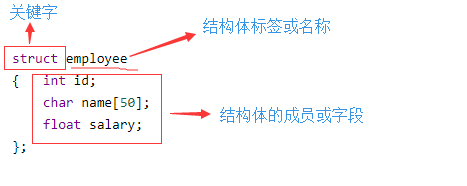C語言結構體
C語言中的結構體是一種用戶定義的數據類型,可以保存不同類型的數據元素。
結構體的每個元素都稱爲成員。
它像C++中的模板和Java中的類一樣工作。可以有不同類型的元素。
例如,結構體可廣泛用於存儲學生信息,員工信息,產品信息,圖書信息等。
定義結構體
struct關鍵字用於定義結構體。下面我們來看看在C語言中定義結構體的語法。
struct structure_name
{
data_type member1;
data_type member2;
.
.
data_type memeberN;
};下面來看看如何在C語言中定義員工結構體的例子。
struct employee
{ int id;
char name[50];
float salary;
};這裏,struct是關鍵字,employee是結構體的標籤名稱; id,name和salary是結構體的成員或者字段。讓我們通過下面給出的圖來理解它:

聲明結構體變量
我們可以爲結構體聲明變量,以便訪問結構體的成員。聲明結構體變量有兩種方法:
- 通過
main()函數中的struct關鍵字 - 通過在定義結構時聲明變量。
第一種方式:
下面來看看一下struct struct來聲明結構變量的例子。它應該在主函數中聲明。
struct employee
{ int id;
char name[50];
float salary;
};現在在main()函數中寫入給定的代碼,如下 -
struct employee e1, e2;第二種方式:
下面來看看在定義結構體時聲明變量的另一種方法。
struct employee
{ int id;
char name[50];
float salary;
}e1,e2;哪種方法好?
但如果變量個數不固定,使用第一種方法。它爲您提供了多次聲明結構體變量的靈活性。
如果變量變量個數是固定的,使用第二種方法。它在main()函數代碼中保存聲明的變量。
訪問結構成員
訪問結構成員有兩種方式:
- 通過符號
.(成員或點運算符) - 通過符號
->(結構指針運算符)
下面下面來看看看代碼訪問p1變量的id成員的.操作符。
p1.id結構體示例
我們來看看一個簡單的C語言結構示例。創建一個工程:structure,並在此工程下創建一個源文件:structure-example.c,其代碼如下所示 -
#include <stdio.h>
#include <string.h>
struct employee
{
int id;
char name[50];
}e1; //declaring e1 variable for structure
int main()
{
//store first employee information
e1.id = 1010;
strcpy(e1.name, "Max Su");//copying string into char array
//printing first employee information
printf("employee 1 id : %d\n", e1.id);
printf("employee 1 name : %s\n", e1.name);
return 0;
}執行上面示例代碼,得到以下結果 -
employee 1 id : 1010
employee 1 name : Max Su下面我們來看看如何使用C語言結構體來存儲多個員工信息的示例。
創建一個源文件:structure-more-employee.c,其代碼如下所示 -
#include <stdio.h>
#include <string.h>
struct employee
{
int id;
char name[50];
float salary;
}e1, e2; //declaring e1 and e2 variables for structure
int main()
{
//store first employee information
e1.id = 1001;
strcpy(e1.name, "Max Su");//copying string into char array
e1.salary = 18000;
//store second employee information
e2.id = 1002;
strcpy(e2.name, "Julian Lee");
e2.salary = 15600;
//printing first employee information
printf("employee 1 id : %d\n", e1.id);
printf("employee 1 name : %s\n", e1.name);
printf("employee 1 salary : %f\n", e1.salary);
//printing second employee information
printf("employee 2 id : %d\n", e2.id);
printf("employee 2 name : %s\n", e2.name);
printf("employee 2 salary : %f\n", e2.salary);
return 0;
}執行上面示例代碼,得到以下結果 -
employee 1 id : 1001
employee 1 name : Max Su
employee 1 salary : 18000.000000
employee 2 id : 1002
employee 2 name : Julian Lee
employee 2 salary : 15600.000000